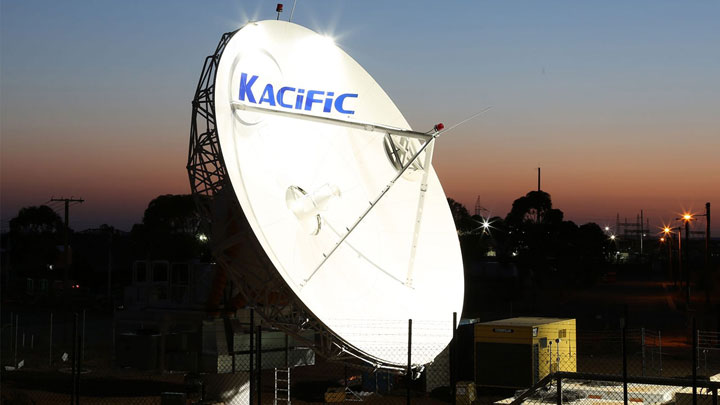SINGAPORE — Asia Pacific is the second largest driver of the global satellite market and with more than 40% of the population still unconnected, it is poised for continued growth in satellite broadband. Within that environment, GEO, LEO and multi-orbit constellation operators have been competing to deploy their capabilities into target markets.
At Asia Satellite Business Week in Singapore, part of Asia’s largest satellite industry event, there was acknowledgement that for such a diverse region, there is no one-orbit-fits-all solution. Panelists presenting the satellite operator’s view on broadband connectivity addressed the tradeoffs between LEO and GEO capabilities, the specific needs of their market and how Starlink’s looming presence is shaping the competitive landscape in Asia.
 Euroconsult Managing Director Canada, Nathan De Ruiter (left) moderated a panel of regional satellite operators at Asia Satellite Business Week in Singapore, June 7, 2023. (Source: SatelliteAsia/Asia Satellite Business Week)
Euroconsult Managing Director Canada, Nathan De Ruiter (left) moderated a panel of regional satellite operators at Asia Satellite Business Week in Singapore, June 7, 2023. (Source: SatelliteAsia/Asia Satellite Business Week)
A Multi-Orbit Strategy
Representatives from JSAT SkyPerfect, Intelsat and SES discussed recent moves to leverage the benefits of each orbit. Intelsat’s distribution partnership with LEO operator and one-time competitor OneWeb is propelling them into multi-orbit connectivity solutions, explained Intelsat Regional VP, Asia Pacific Gaurav Kharod.
“What we’re already seeing in our region, in Asia Pacific, is we are seeing customers, large MNOs [mobile network operators], governments talking about a strategy which is both built on a geostationary solution as well as a LEO constellation,” Kharod said during a panel on broadband connectivity from the perspective of satellite operators. “That is where we are headed.”
The LEO connectivity will cover more latency-sensitive applications, Kharod noted, insisting the overwhelming majority of IP applications can still go through GEO.
In March, Intelsat renewed its 2022 multi-orbit connectivity agreement with OneWeb following the announced merger of OneWeb and GEO fleet operator Eutelsat. The new agreement will be active in 2026 aiming to leverage the two high-capacity GEO networks and LEO fleet for enhanced connectivity solutions to Europe, the Middle East and the Pacific.
SKY Perfect JSAT has also been building out an integrated multi-orbit network including High Altitude Platform Stations (HAPS), as well as GEO and LEO satellites. The network was designed for both communications, data transmission and Earth observation missions, said Koichi Takahara, the Managing Executive Officer, Deputy Unit President of the Space Business Unit of SkyPerfect JSAT.
“We believe that GEO will still be keeping an important role in the future of our networks,” Takahara noted. JSAT’s high-throughput satellites (HTS) enable high-volume data relay from lower orbits back to Earth stations, he continued, suggesting a “new mission” for the company’s GEO fleet.
GEO’s Software-Defined Future
To be sure, the satellite industry is having a LEO moment. Orders for large geostationary satellites have declined in recent years. Euroconsult projects 96% of satellites deployed in the next decade will be destined for low Earth orbit, compared to 2% (roughly 394 satellites) heading to GEO.
Amid growing attention and market interest in LEO, GEO operators emphasized the advancements in capabilities, including software-defined HTS satellites and small GEOs.
CEO of Thaicom Patompob (Nile) Suwansiri described software-defined satellites as “the future for GEOs” because of the flexibility to target and adjust capacity to different areas. Software-defined satellites also lower the investment risk, he continued, saying the idea of a 20-year fixed beam satellite is “a very hard ask” in today’s environment. The Thai government recently allocated Thaicom a 20-year license for two orbital slots. The company will be looking to place orders and is considering different vendor capabilities.
Suawansiri also highlighted the importance of “smart ground systems” to integrate with software-defined satellites, the cloud and even AI. “That will…further new innovative ways to monetize our assets,” he said. “We’re quite interested and embracing this.”
While each operator acknowledged there is a place for assets in various orbits, Christian Patouraux, CEO of Kacific Broadband Satellites took an unequivocal stance saying GEO would be “the mainstream player” in the satellite connectivity market for the foreseeable future.
 A Kacific teleport at Broken Hill, Australia. Kacific is a next-generation broadband satellite operator providing high-speed broadband access to Asia Pacific. (Source: Kacific)
A Kacific teleport at Broken Hill, Australia. Kacific is a next-generation broadband satellite operator providing high-speed broadband access to Asia Pacific. (Source: Kacific)
“We shouldn’t be apologetic about being a GEO operator,” he said. “I think the water is heavily muddied by the LEO constellation. They have their spot in the world but not in my vertical of servicing enterprise or in the rural areas of the developing world.”
Asked what he thought was “the holy grail” of satellite capabilities, Pataroux pointed to software-defined payloads, faster manufacturing processes and the ability to focus smaller spot beams down to the size of a single terminal. Next-generation GEOs are currently being developed with more powerful solid state power amplifiers (SSPAs), which will enable more granular control of beams for more targeted services.
Chyong Lim Yau, Chief Operating Officer at MEASAT, aired a note of caution, saying software-defined satellites can be “pro and con.” For operators that are uncertain of market demand, steerable beams can provide flexibility but throughput could suffer, he said. “If you know your market pretty well, you know your demand, then…probably a fixed link is not a bad idea.”
MEASAT is focused on satellite broadcast services and connecting the unconnected, especially in Malaysia, through satellite broadband direct to home and telco operators.
The SpaceX Factor: Starlink
Starlink has become an inescapable factor for satellite operators and was the subject of numerous questions about the competitive landscape in satellite broadband. Regional operators are keeping a watchful eye on the megaconstellation, especially as it plans and executes market expansion into Indonesia, Japan, Malaysia, Myanmar, Vietnam as well as Australia and New Zealand.
Regional operators generally agreed that it has helped the industry by putting satellite back in the spotlight and improving attitudes toward satellite connectivity. At the same time, they are still cautious.
“As far as from a Malaysian perspective itself, Starlink is knocking at the door heavily,” said Chyong Lim. He said MEASAT was currently looking at ways to work with Starlink as a compliment to its services, rather than a strict competitor.
Several operators alluded to regulators’ concerns about Starlink as they grapple with licensing decisions. “It has taken quite a few regulators aback,” said Pataroux. “Some regulators are not ready to embrace. Some regulators are scratching their heads on [whether we should] allow a foreign operator that will not collaborate with local players. It is challenging for the regulators, generally.”
While Starlink is a strong competitor for consumer broadband and maritime connectivity, most operators were confident that the competition does not extend much farther into verticals where GEO tends to dominate.
Takahara noted that the price point for Starlink in the Japanese market is competitive with other offerings. However, enterprise and government customers who are concerned with security and guaranteed service are less likely to view the megaconstellation as the best or only solution. “Price itself isn’t the only factor of competition,” he said.
Questions remain about the sustainability of Starlink’s pricing model, which has been relatively “opaque” and dependent on subsidies to gain market share. GEO operators, who are accustomed to providing guaranteed services at a committed information rate (CIR) were also skeptical about Starlink’s apparent focus on peak information rate (PIR) and “Best Effort” connectivity.
The issue of reliable, guaranteed bandwidth came up in a separate panel on satellite applications in the maritime sector. Mangata Networks Vice President of Business Development Ashish Thomas emphasized, “Starlink’s contract says on a ‘Best Effort’ basis. My contract says 99.9999. There’s a huge difference when you’re at sea.”
Despina Panayiotou Theodosiou, joint-CEO of Tototheo Maritime, a satcom service distributor and Starlink reseller, agreed. “That’s why I think going forward we will see these hybrid networks onboard ships. We will see a little bit of everything.”
Explore More:
Podcast: Facing Natural Disasters, Endless Grit and Closing the Digital Divide in APAC
Software-Defined Satellites Meet Software-Defined Ground
Podcast: MicroGEO Satellites, Software-Defined Radio and Getting the World Online
The SmallSat Market’s Goldilocks Moment: Too Hot or Too Cold?
